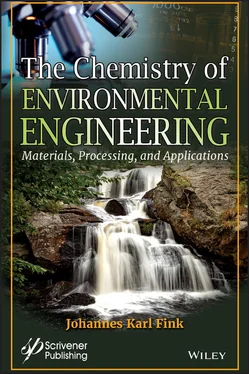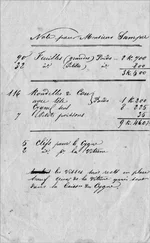1 Cover
2 Preface Preface Preface This book focuses on the chemistry of environmental engineering and applications. Special attention is receiving the use of polymers in this field. Polymers can be created with special properties, such as viscoelasticity, interpenetrating networks, and others. Also, a polymer modified asphalt with special properties can be created. Further, another issue is the creation of polymers with special bacterial adhesion properties. The formation of reverse osmosis membranes that do not show biofouling are of importance for water purification procedures. In another chapter, special processing methods are detailed, such as atom transfer radical polymerization, enzymatic polymerization, plasma treatment, and several other methods. Recycling methods are now important environmental issues for several types of materials, such as PET Bottles, tire rubbers, asphalt compositions, and other engineering resins. Also, wastewater treatment has been detailed. Here, the types of contaminants, such as microplastics, organic dyes, pharmaceutical residues are described and also special methods for proper removal are detailed. Also the types of adsorbents, including also biosorbents are detailed. Still another important issue for environmental engineering chemistry are pesticides. Here also the development and fabrication of special sensors for the detection of certain pesticides are detailed. In a further special chapter, electrical uses are detailed. These include photovoltaic materials, solar cells, energy storage and dielectric applications, light emitting polymers, and fast charging batteries. The recent issues of food engineering, such as food ingredient tracing, protein engineering, biosensors and electronic tongues have been detailed. Finally, medical uses have been described. These fields include drug delivery, tissue engineering, porous coatings and also the special methods of fabrication of such materials. The text focuses mainly on the literature of the past decade. Beyond education, this book will serve the needs of industry engineers and specialists who have only a passing contact with the plastics and composites industries but need to know more.
Preface Acknowledgements Acknowledgements I am indebted to our university librarians, Dr. Christian Hasenhüttl, Margit Keshmiri, Friedrich Scheer, Christian Slamenik, Renate Tschabuschnig, and Elisabeth Groß for support in literature acquisition. I also want to express my gratitude to all the scientists who have carefully published their results concerning the topics dealt with herein. This book could not have been otherwise compiled. Last, but not least, I want to thank the publisher, Martin Scrivener, for his abiding interest and help in the preparation of the text. In addition, my thanks go to Jean Markovic, who made the final copyedit with utmost care. Johannes Fink Leoben
3 1 Special Polymers
1.1 Poly(ethylene)
1.2 Poly(styrene)
1.3 Poly(ethylene terephthalate)
1.4 Silicones
1.5 Self-healing Polymers
1.6 Fibers and Smart Polymers
1.7 Porous Materials
References
4 2 Special Properties of Polymers
2.1 Viscoelasticity
2.2 Impact response of Hybrid Carbon/Glass Fiber Reinforced Polymer Composites
2.3 Mechanical Properties
2.4 Bacterial Adhesion
References
5 3 Processing Methods
3.1 Radiation Processing 3.2 Additive Manufacturing
3.3 Atom Transfer Radical Polymerization
3.4 Reversible Addition-Fragmentation Chain Transfer Polymerization
3.5 Enzymatic Polymerization
3.6 Surface Patterning
3.7 Friction Welding
3.8 Interfacial Engineering
3.9 Plasma Treatment
References
6 4 Recycling
4.1 Recycling Methods 4.2 Materials
References
7 5 Wastewater Treatment
5.1 Properties and Contaminants
5.2 Adsorbents
References
8 6 Pesticides
6.1 Pesticide Carriers 6.2 PCL Nanocapsules
6.3 Self-Decontamination Mechanisms
6.4 Controlled Release of Pesticides
6.5 Sensors
References
9 7 Electrical Uses
7.1 Photovoltaic Materials
7.2 Solar Cells
7.3 Energy Storage and Dielectric Applications
7.4 Light Emitting Polymers
7.5 Fast Charging Batteries
7.6 Electrical Power Cable Engineering
References
10 8 Food Engineering
8.1 Software
8.2 Materials
8.3 Protein Engineering
8.4 Instrumentation and Sensors
8.5 Ultrasonic Methods
References
11 9 Medical Uses
9.1 Drug Delivery 9.2 Porous Bioresorbable Polymers
9.3 Tissue Engineering
References
12 Index
Acronyms Chemicals
General Index
13 Also of Interest
14 End User License Agreement
1 Chapter 1Table 1.1 Chemical composition of natural fibers (87).Table 1.2 Natural fiber composite applications in industry (87, 89, 90).Table 1.3 Methods and monomers for synthesis (96).Table 1.4 Properties of a PMMA foam (105).Table 1.5 Mixture proportions porous Concrete (124).
2 Chapter 2Table 2.1 Polymers for asphalts (16).Table 2.2 Branched chain monomers (29).Table 2.3 Crosslinking agents (29).Table 2.4 Preferred molecular weights (30).
3 Chapter 3Table 3.1 Main methods of additive manufacturing (8).Table 3.2 Monomers for RAFT polymerization (42).Table 3.3 Melt flow index with various reinforcements (47).Table 3.4 Mechanical, chemical and thermal properties of ABS and PA6 (50).Table 3.5 MFI with with different amounts of Fe (50).Table 3.6 Experimental conditions (91).
4 Chapter 4Table 4.1 Chemical recycling processes for PET (1, 23).Table 4.2 Properties of the aerogel (22).
5 Chapter 5Table 5.1 Properties of Wastewater and their Sources (5).Table 5.2 Treatment methods for wastewater.Table 5.3 Biomass-based sorbents (29).
6 Chapter 6Table 6.1 Effect of Pluronic P123 and F68 on the properties (20).
7 Chapter 7Table 7.1 Ceramic fillers for polymers (9).Table 7.2 Performances of PLEDs with PFNBr-BTDZ05 emitter (40).Table 7.3 Colors of light emitting polymers.
8 Chapter 8Table 8.1 Polysaccharides (12).Table 8.2 Applications of low power ultrasound (49).Table 8.3 Applications and characteristics of high power ultrasound in some...
9 Chapter 9Table 9.1 Role of trace elements in the human body (3).Table 9.2 Compositions of nano carriers (10).Table 9.3 Materials for a bioactive ceramic scaffold (11).Table 9.4 Properties of the PDLLA foams prepared by freeze-drying a 5wt:v% ...Table 9.5 Glass formulations (26).Table 9.6 Common Bioactive Glass Compositions for Manufacturing Coatings on...Table 9.8 3D-printed PLA-based materials with fused deposition modelling (4...
1 Chapter 1Figure 1.1 Ethylene-bis(tetrahydroindenyl) zirconium dichloride.Figure 1.2 Vinyl triethoxysilane.Figure 1.3 Young’s modulus versus CNT volume fraction (9).Figure 1.4 polymerization of amino-containing styrenic monomers (15).Figure 1.5 Terpenes.Figure 1.6 3-Tris(trimethylsiloxy)silylpropyl sulfonate.Figure 1.7 Surfactants.Figure 1.8 Cationic silicone surfactants.Figure 1.9 Synthesis silicone surfactant (37).Figure 1.10 Poly(oxyethylene trisiloxane).Figure 1.11 Variation of the surface tension with the concentration of sur...Figure 1.12 Si4-PEGn, Si4Ph3-PEGn, Si4Ph6-PEGn.Figure 1.13 Synthesis of BAAM copolymers (78).Figure 1.14 compounds for fluorine-containing nanocontainers.Figure 1.15 2-(3-(3-Imidazolylpropyl)ureido)ethyl acrylate.Figure 1.16 Spiropyran mechanophore (84).Figure 1.17 Histidine.Figure 1.18 Diols.Figure 1.19 Diisocyanate monomers.Figure 1.20 Polythiol crosslinking agents.Figure 1.21 2,2´-Dimethoxy-2-phenylacetophenone.Figure 1.22 Isosorbide.
Читать дальше












